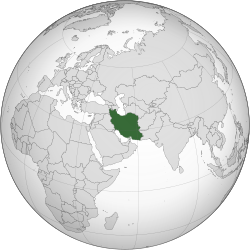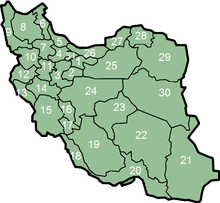Iran
Iran or Persie, kent as the Islamic Republic o Iran, is a kintra in Wastren Asie.[10][11] Wi ower 81 million indwallers,[12] Iran is the warld's 18t maist populous kintra.[13] Comprisin a laund airt o 1,648,195 km2 (636,372 sq mi), it is the seicont lairgest kintra in the Middle East an the 17th maistmuckle in the warld. Iran haes mairches tae the northwast wi Armenie an the Republic o Azerbaijan,[a] tae the north bi the Caspian Sea, tae the northeast bi Turkmenistan, tae the east bi Afghanistan an Pakistan, tae the sooth bi the Persie Gulf an the Gulf o Oman, an tae the wast bi Turkey an Iraq. The kintra's central location in Eurasie an Wastren Asia, an its proximity tae the Strait o Hormuz, gie it geostrategic importance.[14] Tehran is the kintra's caipital an mucklemaist city, as weel as its leadin economic an cultural centre.
Islamic Republic o Iran جمهوری اسلامی ایران (Persie) Jomhuri-ye Eslāmi-ye Irān | |
|---|---|
Motto: استقلال، آزادی، جمهوری اسلامی Esteqlāl, Āzādi, Jomhuri-ye Eslāmi | |
Anthem: سرود ملی جمهوری اسلامی ایران Sorud-e Melli-ye Jomhuri-ye Eslāmi-ye Irān ("Naitional Anthem o the Islamic Republic o Iran") | |
 | |
| Caipital and largest city | Tehran 35°41′N 51°25′E / 35.683°N 51.417°E |
| Offeecial leids | Persie |
| Recognised regional leids | |
| Releegion | Offeecial: Islam (Shia) Ither recognised releegions: |
| Demonym(s) | Iranian, Persie |
| Govrenment | de jure: Islamic Republic de facto: Theocratic-republican hybrid; unitar presidential republic subject tae a Supreme Leader[2] |
| Ali Khamenei (سید علی خامنهای) | |
• Preses | Ebrahim Raisi (سیدابراهیم رئیسی) |
| Mohammad Mokhber (محمد مخبر) | |
| Mohammad Bagher Ghalibaf (محمد باقر قالیباف) | |
| Gholam-Hossein Mohseni-Eje'i (غلامحسین محسنی اژهای) | |
| Legislatur | Islamic Consultative Assembly |
| Unification | |
| c. 678 BC | |
| 550 BC | |
| 247 BC | |
| 224 AD[3] | |
| 1501[4] | |
| 1 Apryle 1979 | |
| 24 October 1979 | |
| 28 Julie 1989 | |
| Aurie | |
• Total | 1,648,195 km2 (636,372 sq mi) (17t) |
• Water (%) | 0.7 |
| Population | |
• 2016 estimate | 82,800,000[5] (18t) |
• Density | 48/km2 (124.3/sq mi) (162nt) |
| GDP (PPP) | 2017 estimate |
• Total | $1.551 trillion[6] (18t) |
• Per capita | $19,050[6] |
| GDP (nominal) | 2017 estimate |
• Tot | $438.3 billion[6] (27t) |
• Per capita | $5,383[6] |
| Gini (2013) | 37.4[7] medium |
| HDI (2014) | heich · 69t |
| Currency | Rial (ریال) (IRR) |
| Time zone | UTC+3:30 (IRST) |
• Summer (DST) | UTC+4:30 (IRDT) |
| Date format | yyyy/mm/dd (SH) |
| Drivin side | richt |
| Cawin code | +98 |
| ISO 3166 code | IR |
| Internet TLD | |

Iran is hame tae ane o the warld's auldest ceevilisations,[15][16] beginnin wi the formation o the Elamite kinricks in the fowert millennium BCE. It wis first unifee'd bi the Iranian Medes in the seivent century BCE,[17] reachin its greatest territorial size in the saxt century BCE, whan Cyrus the Great foondit the Achaemenid Empire, that stretched frae Eastern Europe tae the Indus Valley, becomin ane o the mucklemaist empires in history.[18] The Iranian realm fell tae Alexander the Great in the fowert century BCE an wis dividit intae several Hellenistic states. An Iranian rebellion culminatit in the establishment o the Parthian Empire, that wis succeedit in the third century CE bi the Sasanian Empire, a leadin warld pouer for the next fower centuries.[19][20]
Arab Muslims conquered the empire in the seivent century CE. The Islamisation o Iran led tae the decline o Zoroastrianism, that wis bi then the kintra's dominant releegion, an Iran's major contreibutions tae airt an science spreid within the Muslim rule in the Islamic Gowden Age. Efter twa centuries, a period o various native Muslim dynasties begoud, that were later conquered bi the Seljuq Turks an the Ilkhanate Mongols. The rise o the Safavids in the 15t century led tae the reestablishment o a unifee'd Iranian state an naitional identity,[21] wi the kintra's conversion tae Shia Islam merkin a turnin point in Iranian an Muslim history.[4][22] Unner Nader Shah, Iran wis ane o the maist pouerfu states in the 18t century,[23] tho bi the 19t century, a series o conflicts wi the Russian Empire led tae signeeficant territorial losses.[24][25] The Iranian Constitutional Revolution in the early 20t century led tae the establishment of a constitutional monarchy an the kintra's first legislatur. A 1953 coup instigatit bi the Unitit Kinrick an the Unitit States resultit in greater autocracy an growin Wastren poleetical influence.[26] Subsequent widespreid dissatisfaction an unrest against the monarchy led tae the 1979 Revolution an the establishment o an Islamic republic,[27] a poleetical seestem that includes elements o a pairlamentar democracy vettit an supervised bi a theocracy govrened bi an autocratic "Supreme Leader".[28] In the 1980s, the kintra wis engaged in a war wi Iraq, that lastit for awmaist nine year an resultit in a heich nummer o casualties an economic losses for baith sides.
The sovereign state o Iran is a foondin member o the UN, ECO, NAM, OIC, an OPEC. It is a major regional an middle pouer,[29][30] an its lairge reserves o fossil fuels – that include the warld's lairgest naitural gas supply an the fowert lairgest pruiven ile reserves[31][32] – exert conseederable influence in internaitional energy security an the warld economy.
The kintra's rich cultural legacy is reflectit in pairt bi its 22 UNESCO Warld Heritage steids, the third lairgest nummer in Asie an 11t lairgest in the warld.[33] Iran is a multicultural kintra comprisin numerous ethnic an lingueestic groups, the lairgest bein Persies (61%), Azeris (16%), Kurds (10%), an Lurs (6%).[34]
Notes
eedit- ↑ Includin the de facto independent, but unrecognised Republic o Artsakh.
References
eedit- ↑ "Archived copy". Archived frae the original on 19 August 2012. Retrieved 11 Mey 2017.CS1 maint: archived copy as title (link)
- ↑ Buchta, Wilfried. "Taking Stock of a Quarter Century of the Islamic Republic of Iran" (PDF). Harvard Law School. Harvard Law School. Archived frae the original (PDF) on 8 September 2015. Retrieved 2 November 2015.
[...] the Islamic Republic’s political system, a theocratic-republican hybrid [...]
- ↑ Alireza Shapur Shahbazi (2005), "The History of the Idea of Iran", in Vesta Curtis ed., Birth of the Persian Empire, IB Tauris, London, p. 108: "Similarly the collapse of Sassanian Eranshahr in AD 650 did not end Iranians' national idea. The name 'Iran' disappeared from official records of the Saffarids, Samanids, Buyids, Saljuqs and their successor. But one unofficially used the name Iran, Eranshahr, and similar national designations, particularly Mamalek-e Iran or "Iranian lands", which exactly translated the old Avestan term Ariyanam Daihunam. On the other hand, when the Safavids (not Reza Shah, as is popularly assumed) revived a national state officially known as Iran, bureaucratic usage in the Ottoman empire and even Iran itself could still refer to it by other descriptive and traditional appellations".
- ↑ a b Andrew J. Newman (21 Apryle 2006). Safavid Iran: Rebirth of a Persian Empire. I.B.Tauris. ISBN 978-1-86064-667-6. Retrieved 21 Juin 2013. Cite error: Invalid
<ref>tag; name "Andrew J. Newman 2006" defined multiple times wi different content - ↑ "The World Factbook — Central Intelligence Agency". Archived frae the original on 3 Februar 2012. Unknown parameter
|deadurl=ignored (help) - ↑ a b c d "Report for Selected Countries and Subjects".
- ↑ "GINI index (World Bank estimate)". Data.worldbank.org. Retrieved 29 November 2015.
- ↑ "Human Development Report 2015" (PDF). United Nations. 2015. Retrieved 15 December 2015.
- ↑ Jeroen Temperman (2010). State-Religion Relationships and Human Rights Law: Towards a Right to Religiously Neutral Governance. BRILL. pp. 87–. ISBN 90-04-18148-2.
The official motto of Iran is Takbir ("God is the Greatest" or "God is Great"). Transliteration Allahu Akbar. As referred to in art. 18 of the constitution of Iran (1979). The de facto motto however is: "Independence, freedom, the Islamic Republic."
- ↑ ""CESWW" – Definition of Central Eurasia". Cesww.fas.harvard.edu. Archived frae the original on 5 August 2010. Retrieved 1 August 2010. Unknown parameter
|deadurl=ignored (help) - ↑ "Iran Guide". National Geographic. 14 Juin 2013. Archived frae the original on 12 December 2009. Retrieved 21 Juin 2013. Unknown parameter
|deadurl=ignored (help) - ↑ Cite error: Invalid
<ref>tag; no text was provided for refs namedamar.org.ir - ↑ "National Census Preliminary Results Released: Iran's Urban Population Up". Financial Tribune (in Inglis). 13 Mairch 2017. Retrieved 28 Mey 2017.
- ↑ "Iran's Strategy in the Strait of Hormuz". The Diplomat. Archived frae the original on 8 December 2015. Retrieved 29 November 2015. Unknown parameter
|deadurl=ignored (help) - ↑ Whatley, Christopher (2001). Bought and Sold for English Gold: The Union of 1707. Tuckwell Press.
- ↑ Lowell Barrington (Januar 2012). Comparative Politics: Structures and Choices, 2nd ed.tr: Structures and Choices. Cengage Learning. p. 121. ISBN 978-1-111-34193-0. Retrieved 21 Juin 2013.
- ↑ Encyclopædia Britannica. "Encyclopædia Britannica Encyclopedia Article: Media ancient region, Iran". Britannica.com. Retrieved 25 August 2010.
- ↑ David Sacks; Oswyn Murray; Lisa R. Brody; Oswyn Murray; Lisa R. Brody (2005). Encyclopedia of the ancient Greek world. Infobase Publishing. pp. 256 (at the right portion of the page). ISBN 978-0-8160-5722-1. Retrieved 17 August 2016.
- ↑ Stillman, Norman A. (1979). The Jews of Arab Lands. Jewish Publication Society. p. 22. ISBN 0827611552.
- ↑ Jeffreys, Elizabeth; Haarer, Fiona K. (30 September 2006). Proceedings of the 21st International Congress of Byzantine Studies: London, 21–26 August, 2006, Volume 1. Ashgate Publishing. p. 29. ISBN 075465740X.CS1 maint: multiple names: authors leet (link)
- ↑ Cite error: Invalid
<ref>tag; no text was provided for refs namedSarkhosh - ↑ Savory, R. M. "Safavids". Encyclopaedia of Islam (2nd ed.).
- ↑ Axworthy, Door Michael (2006). The Sword of Persia: Nader Shah, from Tribal Warrior to Conquering Tyrant. ISBN 9780857721938. Retrieved 27 Mey 2014.
- ↑ Fisher et al. 1991, pp. 329–330.
- ↑ Dowling, Timothy C. (2 December 2014). Russia at War: From the Mongol Conquest to Afghanistan, Chechnya, and Beyond. ABC-CLIO. pp. 728–730. ISBN 1598849484.
- ↑ Cordesman, Anthony H. (1999). Iran's Military Forces in Transition: Conventional Threats and Weapons of Mass Destruction. p. 22. ISBN 9780275965297.
- ↑ "Iran". Encyclopædia Britannica. Encyclopædia Britannica. 2012. Retrieved 8 August 2012.
- ↑ قانون اساسی جمهوری اسلامی ایران (in Persian). Archived frae the original on 10 Apryle 2008. Retrieved 23 Januar 2008. Unknown parameter
|deadurl=ignored (help) - ↑ The Committee Office, House of Commons. "Select Committee on Foreign Affairs, Eighth Report, Iran". Publications.parliament.uk. Retrieved 18 Juin 2011.
- ↑ "Iran @ 2000 and Beyond lecture series, opening address, W. Herbert Hunt, 18 May 2000". Archived frae the original on 3 Januar 2010. Retrieved 21 Juin 2013.
- ↑ "UPDATE 3-BP cuts global gas reserves estimate, mostly for Russia". Reuters.com. 2013. Archived frae the original on 24 September 2015. Retrieved 29 November 2015.
- ↑ CIA World Factbook. "Iran". Archived frae the original on 3 Februar 2012. Retrieved 24 Mey 2018.
- ↑ "World Heritage List". UNESCO.
- ↑ Cite error: Invalid
<ref>tag; no text was provided for refs namedworldfactbook
| Wikimedia Commons haes media relatit tae Iran. |
Coordinates: 32°N 53°E / 32°N 53°E
| This Asie-relatit airticle is a stub. Ye can help Wikipaedia bi expandin it. |

